Radiator Replacement 4.3, 4.8, 5.3, 6.0, and 8.1 L Engines
Removal Procedure
- Remove the radiator inlet hose. Refer to Radiator Inlet Hose Replacement .
- Remove the radiator outlet hose. Refer to Radiator Outlet Hose Replacement .
- Remove the lower fan shroud. Refer to Engine Coolant Fan Lower Shroud Replacement .
- If equipped with the 4.8L, 5.3L, or 6.0L engine perform the following:
- Reposition the surge tank hose clamp at the radiator.
- Remove the surge tank hose from the radiator.
- Disengage the plastic caps from the quick connect fitting.
- Hold one leg of the retaining clip.
- Using a small pick-type tool (or bent screwdriver), gently pull the other end of the retaining clip from the quick connect fitting.
- Rotate the retaining clip out of the quick connect fitting.
- Remove the retaining clip completely.
- Discard the OLD retaining clip.
- Perform the above steps for all quick connect fittings on the radiator.
- If equipped with a 6.0L engine, gently pull the engine oil cooler pipes straight out from the radiator quick connect fittings.
- If equipped with a 8.1L engine, gently pull the engine oil cooler pipes straight out from the radiator quick connect fittings.
- If equipped, gently pull the transmission oil cooler pipes straight out from the radiator quick connect fittings.
- Remove the radiator bolts.
- Tilt the radiator slightly in towards the engine.
- Pull the radiator up from the support.

| • | Reposition the radiator vent inlet hose clamp at the radiator. |
| • | Remove the vent inlet hose from the radiator. |

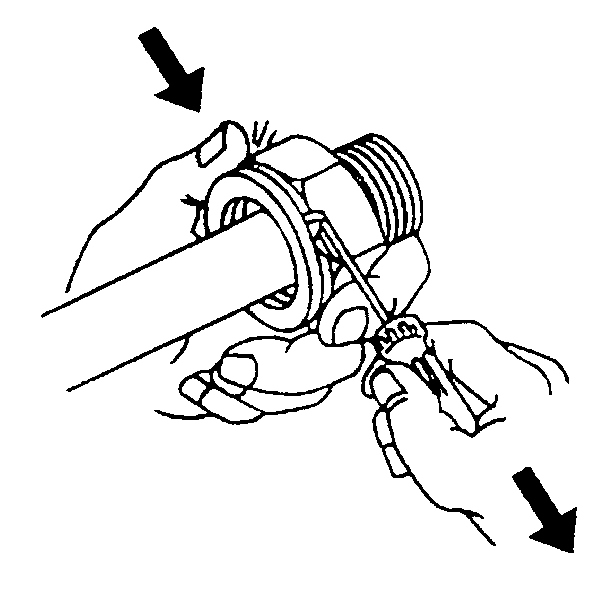
Pull the caps back along the pipe.

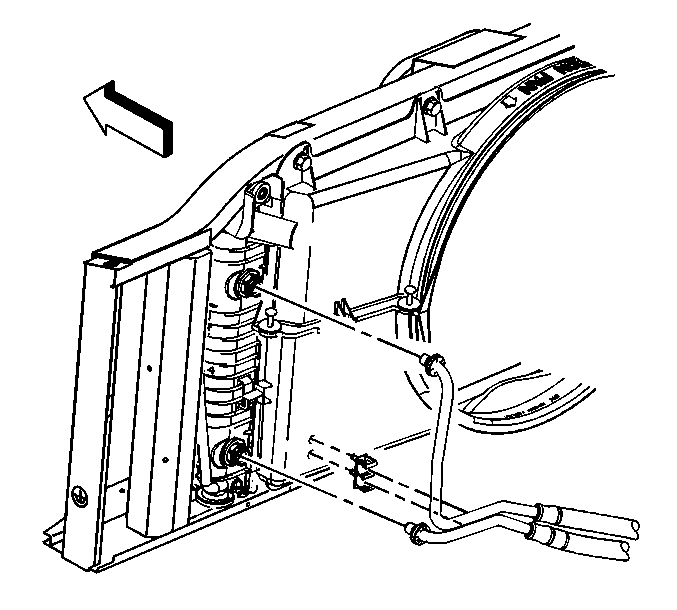
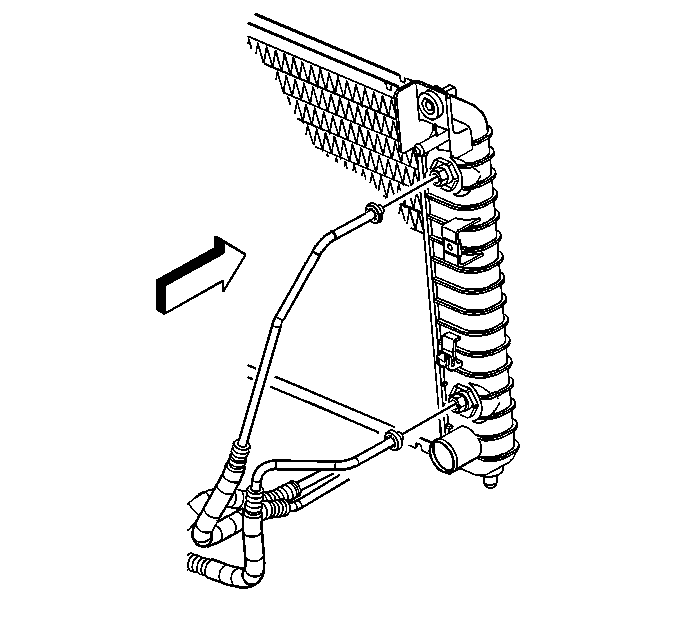
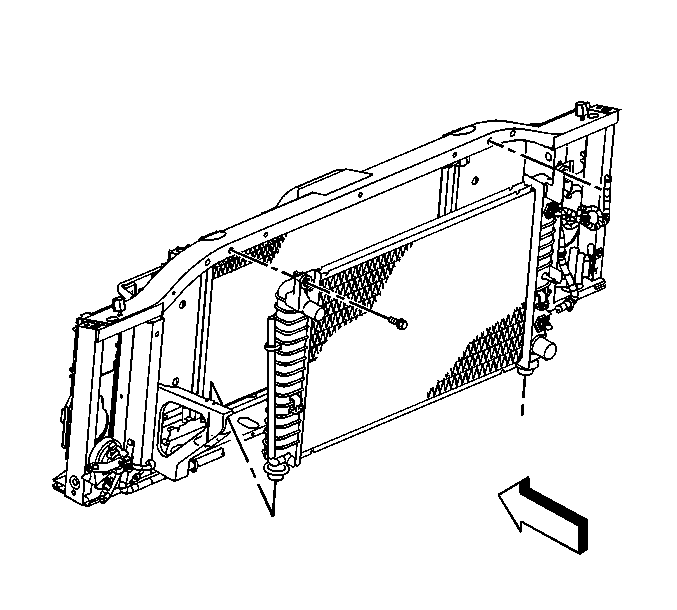
Installation Procedure
- Install the radiator by pushing down, until the lower mounts rest on the radiator support.
- Install the radiator bolts.
- If a NEW radiator is being installer, proceed to step 10.
- If the OLD radiator is to be re-installed, proceed to the next step.
- Install NEW retaining clips into the quick connect fittings.
- Install the NEW retaining clip into the quick connect fitting by using your thumb and forefinger. Insert the new retaining clip into one of the three recesses. Ensure that the retaining clip is engaged in all 3 slots.
- With one end of the retaining clip engaged in the connector fitting slot, use your thumb in order to rotate the retaining clip around the connector fitting, until the retaining clip snaps into place.
- Ensure that the 3 retaining clip ears are seen from inside the fitting and that the retaining clip moves freely in the fitting slots.
- Install NEW retaining clips into the remaining quick connect fittings.
- If equipped, install the transmission oil cooler line straight into the quick connect fitting.
- If equipped with a 8.1L engine, install the engine oil cooler line straight into the quick connect fitting.
- If equipped with a 6.0L engine, install the engine oil cooler line straight into the quick connect fitting.
- Pull back sharply on the cooler line in order to ensure that the cooler line is installed in the quick connect fitting.
- Snap the plastic cap onto the quick connect fitting.
- Ensure that the plastic cap is fully seated against the fitting.
- Ensure that no gap is present between the cap and the fitting.
- Ensure that the yellow identification band on the tube is hidden within the quick connect fitting. A hidden yellow identification band indicates proper joint seating.
- Install the surge tank hose to the radiator.
- Position the surge tank hose clamp at the radiator.
- If equipped with the 4.8L, 5.3L, or 6.0L engine, perform the following:

Notice: Use the correct fastener in the correct location. Replacement fasteners must be the correct part number for that application. Fasteners requiring replacement or fasteners requiring the use of thread locking compound or sealant are identified in the service procedure. Do not use paints, lubricants, or corrosion inhibitors on fasteners or fastener joint surfaces unless specified. These coatings affect fastener torque and joint clamping force and may damage the fastener. Use the correct tightening sequence and specifications when installing fasteners in order to avoid damage to parts and systems.
Tighten
Tighten the radiator bolts to 25 N·m (18 lb ft).

Do not install the retaining clips onto the fittings by pushing on the clip.

Important: failure to properly install the retaining clip could cause the cooler line to come loose and cause damage to the engine.
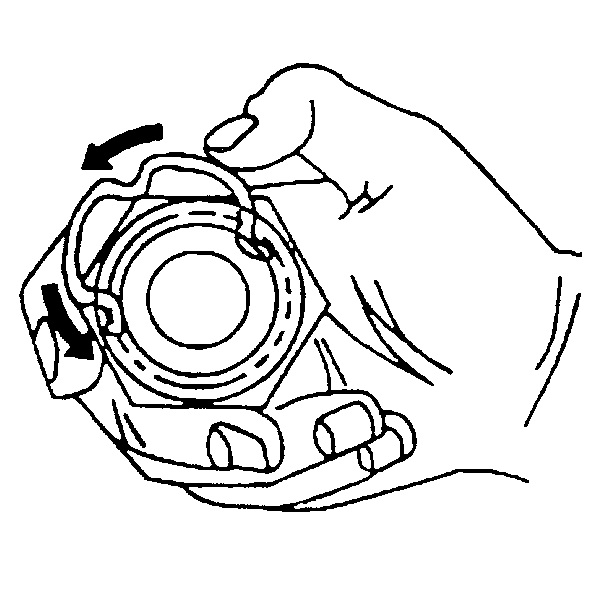


Important: Ensure the oil cooler line being installed has a plastic cap on the end that connects to the quick connect fitting. If no plastic cap exists, or the plastic cap is damaged, obtain a new cap. Install the cap on to the cooler line prior to cooler line installation.
Insert the cooler line end into the quick connect fitting until a click is either heard of felt.

Insert the cooler line end into the quick connect fitting until a click is either heard of felt.

Insert the cooler line end into the quick connect fitting until a click is either heard of felt.

Important: Do not use the plastic cap in order to install the cooler line into the fitting.
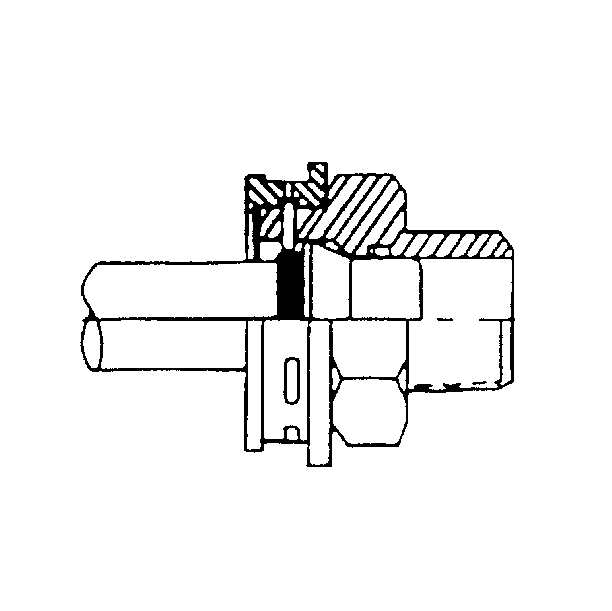
Important: Do not manually depress the retaining clip when installing the plastic cap.
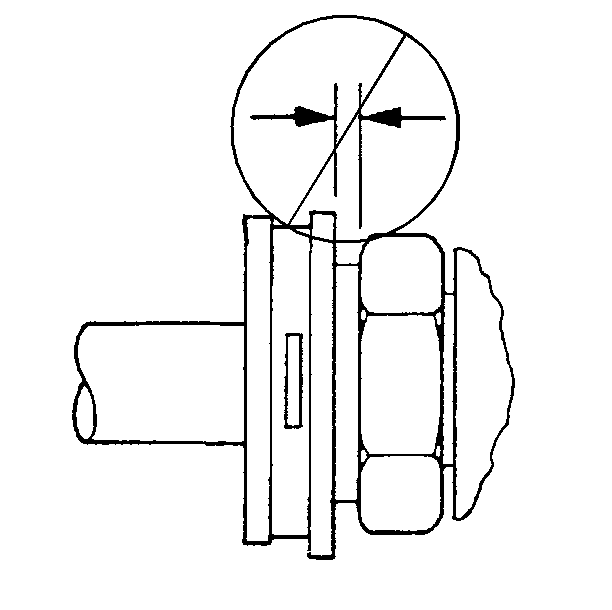



| • | Install the radiator vent inlet hose to the radiator. |
| • | Position the vent inlet hose clamp at the radiator. |
| • | Install the lower fan shroud. Refer to Engine Coolant Fan Lower Shroud Replacement . |
| • | Install the radiator outlet hose. Refer to Radiator Outlet Hose Replacement . |
| • | Install the radiator inlet hose. Refer to Radiator Inlet Hose Replacement . |
Radiator Replacement 6.6 L Engine
Removal Procedure
- Remove the radiator air upper baffle retainers.
- Remove the radiator air upper baffle.
- Remove the radiator inlet hose. Refer to Radiator Inlet Hose Replacement .
- Remove the radiator outlet hose. Refer to Radiator Outlet Hose Replacement .
- Remove the lower fan shroud. Refer to Engine Coolant Fan Lower Shroud Replacement .
- Reposition the surge tank hose clamp at the radiator.
- Remove the surge tank hose from the radiator.
- Disengage the plastic caps from the quick connect fitting.
- Hold one leg of the retaining clip.
- Using a small pick-type tool (or bent screwdriver), gently pull the other end of the retaining clip from the quick connect fitting.
- Rotate the retaining clip out of the quick connect fitting.
- Remove the retaining clip completely.
- Discard the OLD retaining clip.
- Perform the above steps for all quick connect fittings on the radiator.
- Gently, pull the transmission oil cooler pipes straight out from the radiator quick connect fittings.
- Remove the radiator bolts.
- Lift the radiator from the lower mounting brackets on the charged air cooler.
- Remove the radiator from the vehicle.
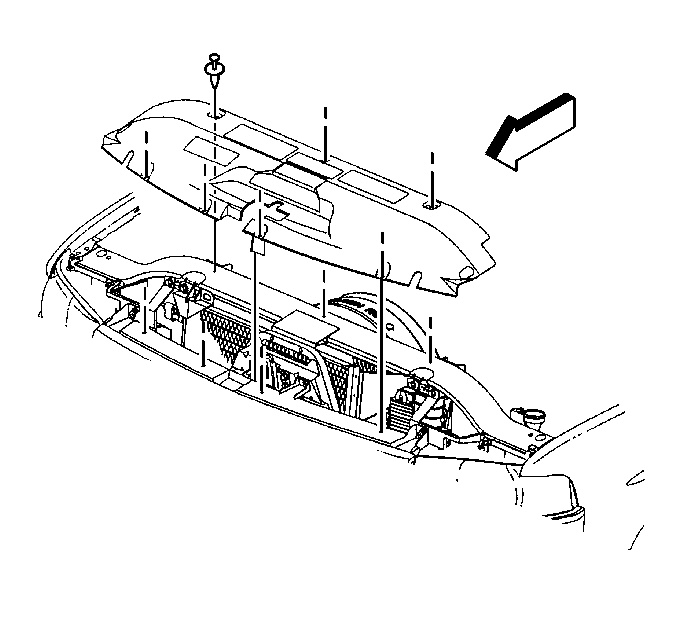


Pull the caps back along the pipe.


Installation Procedure
- Install the radiator until the lower mounts are in the brackets on the charged air cooler.
- Install the radiator bolts.
- If a NEW radiator is being installed, proceed to step 10.
- If the OLD radiator is to be re-installed, proceed to the next step.
- Install NEW retaining clips into the quick connect fittings.
- Install the NEW retaining clip into the quick connect fitting by using your thumb and forefinger. Insert the new retaining clip into one of the three recesses. Ensure that the retaining clip is engaged in all 3 slots.
- With one end of the retaining clip engaged in the connector fitting slot, use your thumb in order to rotate the retaining clip around the connector fitting, until the retaining clip snaps into place.
- Ensure that the 3 retaining clip ears are seen from inside the fitting and that the retaining clip moves freely in the fitting slots.
- Install NEW retaining clips into the remaining quick connect fittings.
- Install the transmission oil cooler line straight into the quick connect fitting.
- Pull back sharply on the cooler line in order to ensure that the cooler line is installed in the quick connect fitting.
- Snap the plastic cap onto the quick connect fitting.
- Ensure that the plastic cap is fully seated against the fitting.
- Ensure that no gap is present between the cap and the fitting.
- Ensure that the yellow identification band on the tube is hidden within the quick connect fitting. A hidden yellow identification band indicates proper joint seating.
- Install the surge tank hose to the radiator.
- Position the surge tank hose clamp at the radiator.
- Install the lower fan shroud. Refer to Engine Coolant Fan Lower Shroud Replacement .
- Install the radiator outlet hose. Refer to Radiator Outlet Hose Replacement .
- Install the radiator inlet hose. Refer to Radiator Inlet Hose Replacement .
- Install the radiator air upper baffle.
- Install the radiator air upper baffle retainers.

Notice: Use the correct fastener in the correct location. Replacement fasteners must be the correct part number for that application. Fasteners requiring replacement or fasteners requiring the use of thread locking compound or sealant are identified in the service procedure. Do not use paints, lubricants, or corrosion inhibitors on fasteners or fastener joint surfaces unless specified. These coatings affect fastener torque and joint clamping force and may damage the fastener. Use the correct tightening sequence and specifications when installing fasteners in order to avoid damage to parts and systems.
Tighten
Tighten the radiator bolts to 25 N·m (18 lb ft).

Do not install the retaining clips onto the fittings by pushing on the clip.

Important: Failure to properly install the retaining clip could cause the cooler line to come loose and cause damage to the engine.



Important: Ensure the transmission oil cooler line being installed has a plastic cap on the end that connects to the quick connect fitting. If no plastic cap exists, or the plastic cap is damaged, obtain a new cap. Install the cap on to the cooler line prior to cooler line installation.
Insert the cooler line end into the quick connect fitting until a click is either heard of felt.

Important: Do not use the plastic cap in order to install the cooler line into the fitting.

Important: Do not manually depress the retaining clip when installing the plastic cap.




